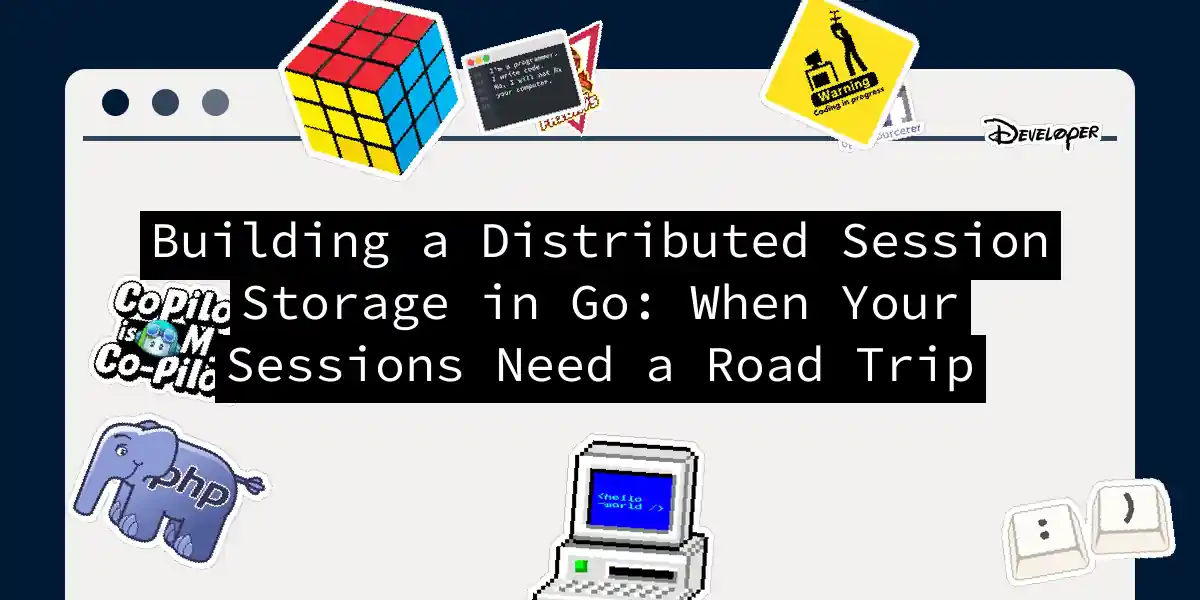Picture this: your user logs in, grabs a digital shopping cart, and suddenly gets routed to a different server that knows nothing about their session. It’s like trying to continue a road trip after someone swapped your car mid-journey. Let’s build a distributed session system that keeps the adventure going - no abandoned carts or logged-out users allowed!
Why Sessions Go Rogue in Distributed Systems
Traditional session storage has all the coordination skills of toddlers playing soccer - everyone chases the same ball. When you scale to multiple servers:
- Local memory storage becomes as reliable as a chocolate teapot
- Sticky sessions turn your load balancer into an overworked travel agent
- Database storage can slow things down like rush hour traffic
Building Our Session Roadmap
Step 1: Choose Your Garage (Storage Engine)
We’re using Redis because it’s faster than a caffeinated squirrel:
type RedisStore struct {
client *redis.Client
ttl time.Duration
}
func NewRedisStore(addr string, ttl time.Duration) (*RedisStore, error) {
client := redis.NewClient(&redis.Options{Addr: addr})
_, err := client.Ping().Result()
if err != nil {
return nil, fmt.Errorf("redis connection failed: %w", err)
}
return &RedisStore{client: client, ttl: ttl}, nil
}
Step 2: Build the Session Hotrod
Our session struct needs to be leaner than a Formula 1 car:
type Session struct {
ID string
Values map[string]interface{}
CreatedAt time.Time
}
type SessionStore interface {
Get(ctx context.Context, id string) (*Session, error)
Save(ctx context.Context, session *Session) error
Delete(ctx context.Context, id string) error
}
Step 3: Middleware Pit Crew
The middleware that keeps everything running smoothly:
func SessionMiddleware(store SessionStore) gin.HandlerFunc {
return func(c *gin.Context) {
sessionID, _ := c.Cookie("session_id")
if sessionID == "" {
// New session creation
session := &Session{
ID: generateUUID(),
Values: make(map[string]interface{}),
CreatedAt: time.Now(),
}
c.Set("session", session)
c.Next()
store.Save(c.Request.Context(), session)
c.SetCookie("session_id", session.ID, 3600, "/", "", true, true)
return
}
session, err := store.Get(c.Request.Context(), sessionID)
if err != nil {
// Handle error like a pro
c.AbortWithStatusJSON(500, gin.H{"error": "session service unavailable"})
return
}
c.Set("session", session)
c.Next()
}
}
The Secret Sauce: Replication Strategy
Our session replication works like a perfect carpool system:
// Hybrid read strategy
func (r *RedisStore) Get(ctx context.Context, id string) (*Session, error) {
// 90% of reads from replicas
if rand.Intn(10) < 9 {
client := pickRandomReplica(r.replicas)
return r.getFromClient(ctx, client, id)
}
return r.getFromClient(ctx, r.master, id)
}
Handling Session Crashes (Because Life Happens)
Implement circuit breakers to prevent total meltdowns:
type CircuitBreaker struct {
failures int
lastFailure time.Time
mutex sync.Mutex
}
func (cb *CircuitBreaker) Execute(fn func() error) error {
cb.mutex.Lock()
defer cb.mutex.Unlock()
if cb.failures > 5 && time.Since(cb.lastFailure) < time.Minute {
return errors.New("circuit breaker open")
}
err := fn()
if err != nil {
cb.failures++
cb.lastFailure = time.Now()
}
return err
}
Performance Tuning: From Golf Cart to Rocket Ship
- Connection pooling: Because opening new connections for each request is like building a new highway every time someone wants to drive
- Lazy expiration: Clean up expired sessions when you read them, like picking up trash on your daily walk
- Compression: Squish session data smaller than a clown car
func compressSession(data []byte) []byte {
var b bytes.Buffer
gz := gzip.NewWriter(&b)
gz.Write(data)
gz.Close()
return b.Bytes()
}
Security: Locking Your Session Treasure Chest
- Encryption: Use AES-GCM like you’re encoding secret messages
- Rotation: Change session IDs more often than a chameleon changes colors
- Validation: Check User-Agent and IP fingerprint like a bouncer checking IDs
func validateSession(s *Session, c *gin.Context) bool {
storedFingerprint, ok := s.Values["fingerprint"].(string)
if !ok {
return false
}
currentFingerprint := fmt.Sprintf("%s|%s",
c.Request.UserAgent(),
c.ClientIP())
return subtle.ConstantTimeCompare(
[]byte(storedFingerprint),
[]byte(currentFingerprint)) == 1
}
The Finish Line
You’ve now built a session system that’s more resilient than a cockroach in a nuclear winter. Remember:
- Test failure scenarios like your Redis cluster decides to go on vacation
- Monitor everything - track session sizes like worried parents track screen time
- Keep sessions lean - nobody needs to store their entire life story in a cookie Now go forth and make those sessions travel in style! Just remember - with great distributed power comes great replication responsibility.
